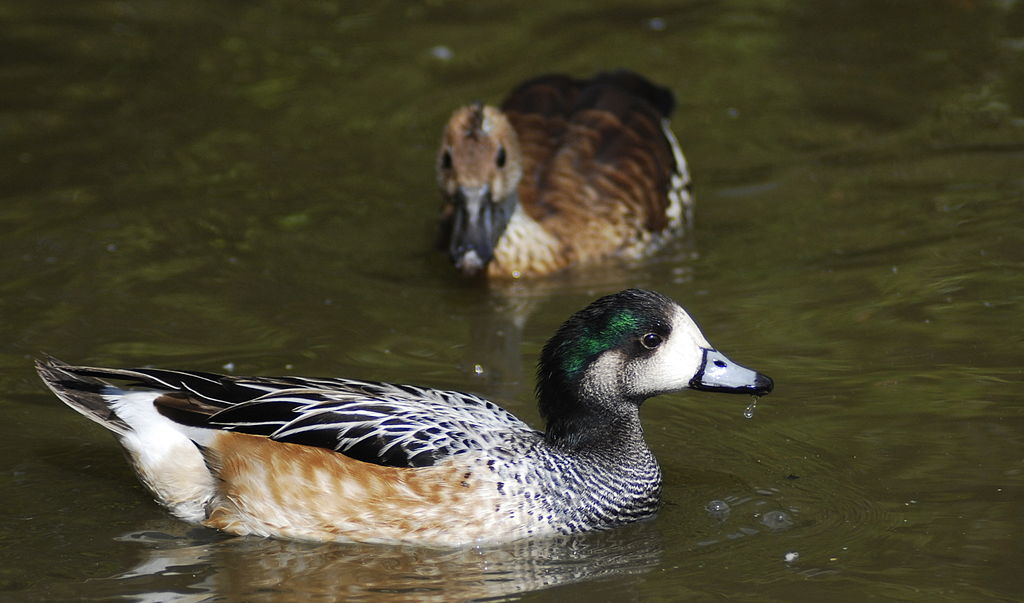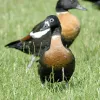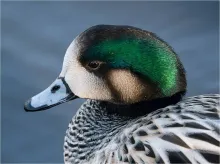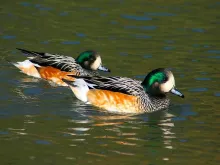
Chiloé wigeon (Mareca sibilatrix)
Species name
- Dutch name:
- Chili smient
- English name:
- Chiloé wigeon
- German name:
- Chilepfeifente
- French name:
- Canard de Chiloé
- Scientific name:
- Mareca sibilatrix
Scientific classification
- Order:
- Anseriformes
- Family:
- Anatidae
- Onderfamilie:
- Anatinae
- Genus:
- Mareca
Description
- Description:
Male:
Iridescent green to blackish head and neck, whiteish face in front of eyes and small whitish patch near ears. Lower neck and breast scalloped black and white, flanks rusty-chestnut; belly, vent and undertail converts white to yellowish-white. Upperparts, including elongated scapulars and tertails, black with white margins; rump and upper tail-coverts white, tail black. Upper wing with primaries and lesser converts dark brown, and speculum Iridescent green and black on feathers, but bordered in front by black tips and white converts; Underwing mainly pale grey-brown, with darker flight feathers and leading edge. Bill bluish-grey, line around base. Legs and feet grey.Female:
As Male But very Dull Iridescent green to blackish head and neck, Grey-whiteish patch in front of eyes. Lower neck and breast scalloped black and white, flanks rusty-chestnut; belly, vent and undertail converts white to yellowish-white. Upperparts, including elongated scapulars and tertails, black with white margins; rump and upper tail-coverts white, tail black. Upper wing and lesser converts dark brown and white mottling. (Which is a key difference from male).Juvenile:
Much Duller then female, with no gloss on eye stripe or whitish ear patch, and heavy brown mottling on forewing.
Standard Measurements
- Body Length (cm):
- The male (drake) of the Chiloé wigeon measures approximately 43-54 centimeters. The female measures approximately 43-54 centimeters.
- Body Weight (grams):
- The male will weight about 816-954 gram. The female will weight about 816-954 gram.
The weight is notoriously variable and can only be used as indication!
- Note:
The female will seek out a nesting site in tall grasses or weeds. The male does not assist in incubation but remains nearby protecting the nest. He will rejoin his mate after the ducklings hatch and attend to the young.
- Breeding:
- The female Chiloé wigeon usually lays from 5-8 white or cream eggs and incubates them for 25-26 days.
- Artificial incubating:
The ideal relative humidity for incubating most waterfowl eggs is 55% (ground nesters) and 40% (cavity nesters). The temperature is usually 37.4°C. Set ventilation as recommended by the incubator manufacturer. Eggs must be turned, either automatically or by hand, a minimum of 4 times a day. As the duckling develops there is a loss of water from the egg and the air sac gets bigger. In normal development of an egg with a 25-26 days incubation, the air sac occupies about a third of it three days earlier. Cleanliness is vital and ideally eggs should be moved to a separate hatcher at this point, where the humidity should be increased to 65% and even higher once they have pipped internally.
- Bird banding:
- Recommended closed leg band ring size for the Chiloé wigeon is 10 mm.The leg band ring can only be applied on a young dabbling duck at around 11-12 days old.
- It doesn't matter what leg that you band, but it's good to have a consistent system. Suggested: Left leg = Female, Right leg = Male
- Maintenance food:
-





Floating full food for all sea ducks, green ducks, eider ducks and geese, especially in the moulting and breeding phase ideally suited. Packed with wholesome raw materials, natural vitamins and trace elements, this performance food with a protein content of 30% forms the basis for lifelong vitality.



